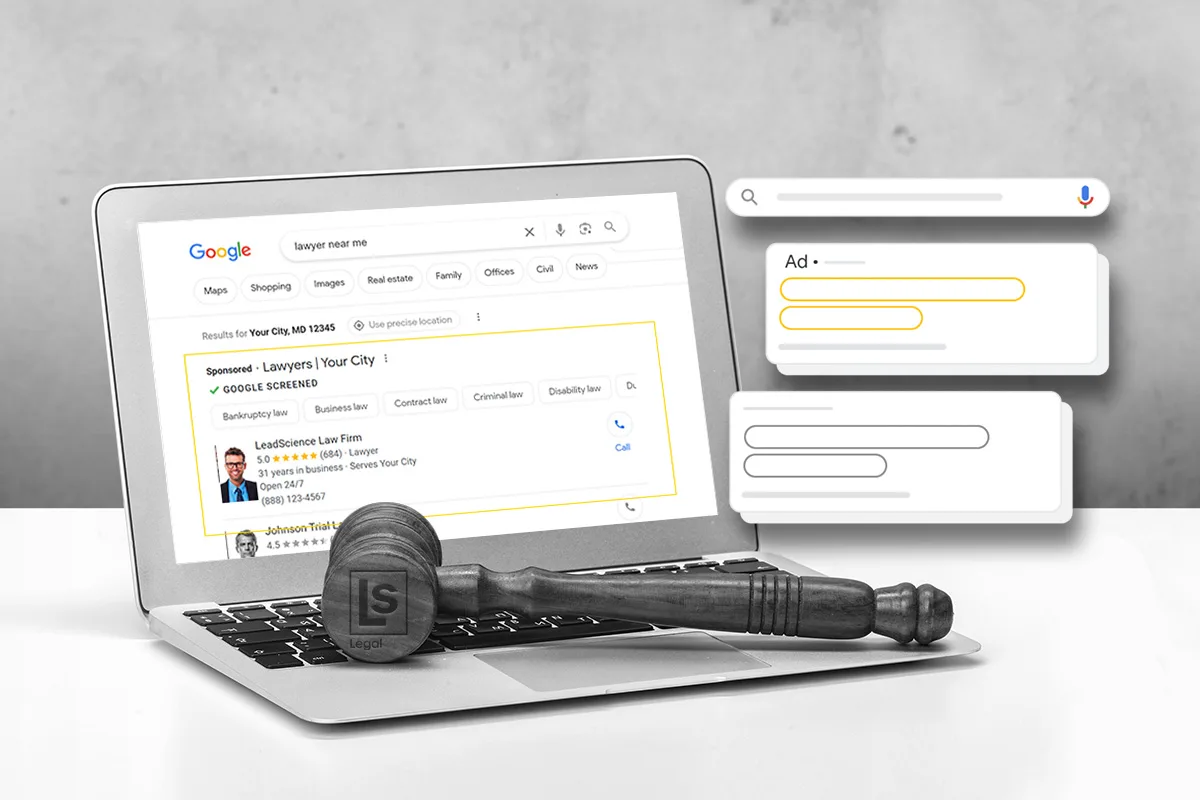Google Ads are an effective but expensive way to increase web traffic for your law firm. Get more bang for your buck by using these best practices.
Over 90% of people will do an online search when they need a lawyer, and over 90% of them will use Google to do it. Advertising on Google just makes good sense. Google Ads is a PPC (Pay-Per-Click) format that allows you to reach precisely the audience likely to convert into clients. For newcomers, Google Ads can be a little intimidating, so we’re going to go over 10 best practices that will help you utilize this powerful tool.
1. Long-Tail Keywords Are Your Friends
Keywords come in three basic varieties: head terms, body terms, and long-tail terms. Differentiated by how many words are in each one, long-tail keywords are phrases of 4 or more words that specifically delineate what a search engine user is looking for. This is where you should focus your Google Ad buying.
Head terms for lawyers are things like “lawyer” or “attorney.” Not terribly useful for several reasons. The first is that someone with a legal problem – your bread and butter – is going to be more specific in their query, likely adding both a specialty and a location to that query. The second is that these head terms are largely owned by simple information sites: Google “lawyer” and the top hits are going to tell you what a lawyer is, which ideally you should know by now.
One of the primary advantages of digital marketing over traditional is the ability to precisely target your ideal audience. Long-tail keywords are where your digital marketing dollars thrive. As an example, an ideal long-tail keyword to target would be “best divorce attorney in Charlotte, North Carolina”. Showing up at the top of search queries with this level of specificity will yield a great return on your ad dollars.
2. Use Negative Keywords
Keywords are the words you want to appear in a search query that results in your ad being shown. Negative keywords are the opposite. Again, these work into one of digital marketing’s great strengths: precision targeting. Negative keywords let you further refine your ad targeting by keeping it away from searchers who would be unlikely to interact with it.
Negative keywords can be things like cities or states where you don’t practice, specialties you don’t cover, or nearly any other aspect of your firm’s way of doing business that might narrow down your client base.
If you’re hunting around for negative keywords, have a look in the Search Terms section under the Keywords column in your Google Ads account. This will show you actual searches that featured your ad. If you’re seeing some words you shouldn’t, add them to your negative keywords.

Include negative keywords into your Google Ads campaigns to ensure your ads are placed in front of an audience most likely to click through.
3. Bid Effectively
Knowing how to bid effectively is a big part of how useful Google Ads ultimately is. Fortunately for you, bidding is a skill like any other and will improve over time. Going in, knowing a few things will undoubtedly assist your learning curve.
When bidding, you have 4 basic options:
- Target CPA: Allows you to input a cost per lead acquisition while Google’s algorithm does the rest.
- Target a Position: Shapes your bid based on where you want to end up (e.g. top section of SERPs, first page of SERPs, etc).
- Enhanced CPC: Trusts the algorithm entirely to get you keywords that convert.
- Maximized Clicks: Automatically sets your bids to get as many clicks as possible within your budget.
Your specific bidding strategy is going to depend on your budget. It’s important to remember not to single-mindedly target that top spot. Much of the time, those go to the big law firms with the bottomless pockets. You’re often best off looking for deals in the 2-4 spots where you can maximize a more modest budget.
4. Bid on Your Branded Term
Your branded terms are things like your firm’s name. Just because it is associated with you doesn’t necessarily mean you will automatically win queries in which it appears. If another firm bids on your firm’s name, they can win those searches in a phenomenon called brand-jacking.
Google makes it easier for businesses to win those kinds of branded struggles by awarding the higher quality score of the legitimate business increased weight in bidding. In short, defending your brand is cheaper than an unrelated term and well worth the price.
5. Themed Ad Groups
Google Ads gives you the option of splitting up your campaigns by theme, which you should take advantage of. Grouping your ads by theme helps target user intent, a primary factor in search queries and helps you organize your marketing efforts.
Themed ad groups allow more precision in targeting, which once again plays into one of the great strengths of digital advertising. The more specialties your firm addresses, and the more you can separate these specialties by client intent, the more use you will see out of this function.
6. Use Keywords in Your Ads
Google ranks the content that appears in a query partly thanks to quality scores, and one of the ways it determines quality is if the words in your ads appear on the site itself. Since Google wants to match content with query, having the same words appear is a basic way to do that.
Seed your keywords through your ad’s title, the display URL, the ad extensions, and the copy itself. Don’t overdo it once is enough for each one – but doing so will help put your ads in front of receptive eyes and will reduce bounce rates as those who click will find what they were looking for.

Incorporating a few strategically placed keywords throughout your Google Ads can boost your chances of your ad landing on your target queries.
7. Leverage Ad Extensions
Ad extensions are free add-ons provide additional context for your Google Ads. These extensions can improve your lead quality, increase your ad ranking scores, and help you maximize your PPC budget.
Each extension makes your ad more noticeable and creates added value for those viewing it:
- Sitelinks: Add more links to your Google Ads.
- Callouts: Promote features or offers special offers for your law firm.
- Call Extensions: Add multiple phone numbers to your Google Ads.
- Location Extensions: Add the physical address of your law office.
All these options can add significant value to Google Ads from your firm and increase your CTR (Click Through Rate).
8. Test Ad Copy
Every aspect of marketing needs rigorous testing. Even the basics that every source assures you are how things are done should be tested, verified, and refined. Testing helps you dial into your specific client base and keeps you marketing effectively to them. Ad copy, where you are communicating directly with them, is no exception.
A/B testing (also referred to as “split-testing”) can serve you well here. This is where you alter a single aspect of an ad – even simple wording – and track the performance of each variant. Test variations on headlines, copy, calls-to-action (CTAs), and display URLs. You never know when a single change is standing between you and an increase in performance.
Google Ads can help you set up an A/B format, loading variants randomly every time they are accessed and tracking the results. Never think you’re finished with testing. There’s always something new to optimize.
9. Responsive Search Ads
Responsive search ads are a new feature Google is rolling out that shows alternate versions of the same ad to a user based on their online profiles. You provide multiple versions of your ad headline and enable automatic testing of different combinations, and Google does the rest.
These are still very new, but early results have been promising. A 50% increase in CTR has already been documented, and it’s not out of the realm of possibility that this will increase as the process grows more refined.
10. Monitor All Conversions
It’s easy to measure CTR, but not every conversion has such an obvious path. Sometimes you will receive a conversion through your form that doesn’t come directly from an ad. Other times, a client will contact you via phone. To truly understand your digital marketing, you need to track these as well.
Set up conversion tracking on your landing pages, which is an easy process powered by a bit of code Google Ads or Google Analytics will generate. Integrate a call-tracking program with Analytics to track how many calls come via a Google Ads search. Record the origin of your leads and ensure that your point of contact is trained in how to do this. Lastly, monitor the revenue from conversions, which can help you not only determine the average income from a new client, but also home in on how to market to high-revenue clients.

Ready for more digital marketing insights? Download our free guide packed with advanced digital marketing strategies designed to fuel the growth of your law firm.
Lead Science: The Digital Advertising Experts
Google Ads is a highly useful tool that needs a little bit of finesse to use well. These best practices will get you started, and the more you use Google Ads, the better you’ll get.
At Lead Science, we’ve worked with Google Ads since its inception, and we know how to get the most out of it. Schedule your Lead Science Discovery Call today. You’ll be stunned at what our engineers can do for your digital marketing.







